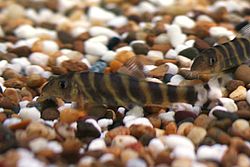This article needs additional citations for verification .(January 2013) |
| Bengal loach | |
|---|---|
 | |
| Scientific classification | |
| Domain: | Eukaryota |
| Kingdom: | Animalia |
| Phylum: | Chordata |
| Class: | Actinopterygii |
| Order: | Cypriniformes |
| Family: | Botiidae |
| Genus: | Botia |
| Species: | B. dario |
| Binomial name | |
| Botia dario (F. Hamilton, 1822) | |
| Synonyms | |
| |
Botia dario (Bengal loach or queen loach) is a species of fish in the loach family Botiidae found in the Brahmaputra and Ganges basins in Bangladesh, Bhutan and northern India. [2] The species is overall widespread. [1]
In Bangladesh, B. dario is threatened by pesticide used in the cultivation of rice. Since 1997, the Bangladesh government has enforced strict penalties against polluters, with specific rules about the pollution of streams and waterways.[ citation needed ]
B. dario can be found in the creeks and streams of the northern and eastern regions of the country (bordering India and Myanmar, respectively). The fish most likely populates the streams that supply the Bengal section of the Ganges River. B. dario is also reported in Bhutan, but only in the Gaylegphug River, which eventually drains into the far north of Bangladesh.[ This paragraph needs citation(s) ]
